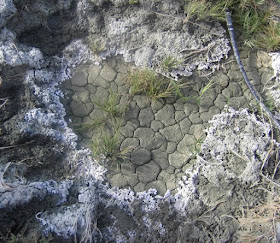 |
| Soil salinization |
Soil salinization is a process in which water-soluble salts build up in the root zones of plants, blocking the movement of water and nutrients into plant tissues.
Soil salinization rarely occurs naturally. It becomes an environmental problem when it occurs as a result of human activity, denuding once vegetated areas of all plant life.
Rainwater is virtually free of dissolved solids, but surface waters and underground waters (groundwater) contain significant quantities of dissolved solids, ultimately produced by the weathering of rocks.
  |
Evaporation of water at the land surface results in an increase in dissolved solids that may adversely affect the ability of plant roots to absorb water and nutrients.
Arid Climates
In arid regions, evaporation of soil water potentially exceeds rainfall. Shallow wetting of the soil followed by surface evaporation lifts the available dissolved solids to near the surface of the soil.
The near-surface soil therefore becomes richer in soluble salts. In natural arid areas, soluble salts in the subsurface are limited in quantity because rock weathering is an extremely slow process. Degrees of soil salinization detrimental to plants are uncommon.
Irrigating arid climate soils with surface or groundwater provides a constant new supply of soluble salt. As the irrigation water evaporates and moves through plants to the atmosphere, the dissolved solid content of the soil water increases. Eventually, the increase in soil salt will inhibit or stop plant growth.
It is therefore necessary to apply much more water to the fields than required for plant growth to flush salts away from the plant root zone. If the excess water drains easily to the ground water zone, the groundwater becomes enriched in dissolved solids, which may be detrimental.
If the groundwater table is near the surface, or if there are impermeable soil zones close to the surface, over irrigation will not alleviate the problem of soil salinization.
This condition requires the installation of subsurface drains that carry the excess soil water and salts to a surface outlet. The problem with this method is that disposing of the salty drain water is difficult. If the drain water is released into surface streams, it degrades the quality of the stream water, adversely affecting downstream users.
If the water is discharged into evaporation ponds, it has the potential to seep into the groundwater zone or produce a dangerously contaminated body of surface water, as occurred at the Kesterson Wildlife Refuge in California, where concentrations of the trace element selenium rose to levels that interfered with the reproduction of resident birds.